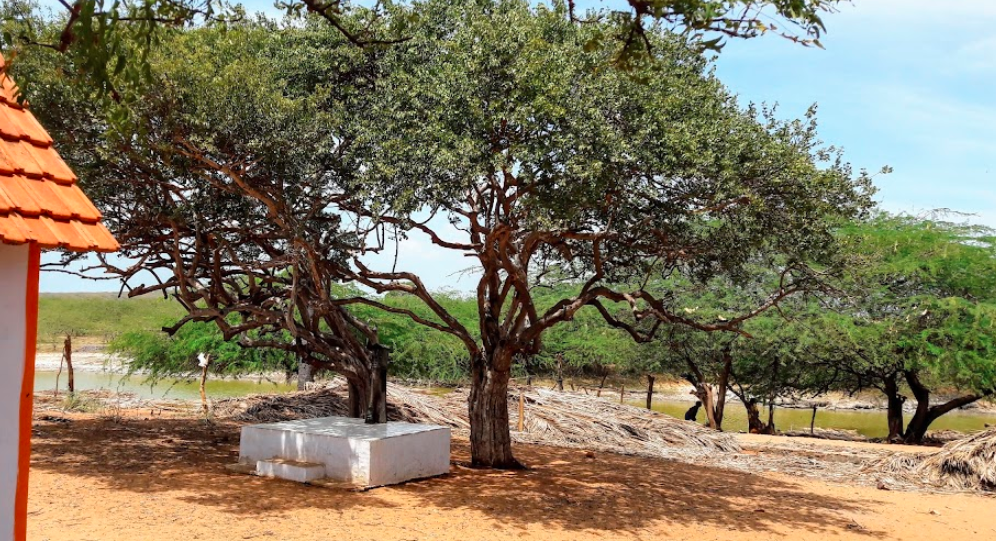The Ancient Thillai Forest
In ancient times Chidambaram was known as Thillai vanam because there was a forest full of a type of Thillai tree. This medicinal thillai tree is the main tree of Chidambaram Nataraja temple . The town got its name as Thillai because of the dense growth of thillai trees in Chidambaram area. Later this town Sidd-Ambaram became Maruvi Chidambaram. Sidh means knowledge and Ambaram means clearing. History says that eventually the town of Thillai was ruined. But thillai trees which once grew like a forest in Chidambaram are not seen even in nominal size today. But now thillai trees are encroaching between the Surappannai forests on the coast of Bichavaram near Chidambaram.

The Medicinal Thillai Tree
Botanical Characteristics
Thillai is a herbaceous plant. Its botanical name is Excoecaria agallocha Linn. means Belonging to the plant family Euphorbiaceae, it is a milky plant. Its milky liquid is said to cause blindness if it gets into the eyes. And botanists say that if it rubs against the body, there is a risk of burning and causing irritation. Thillai tree can grow up to 14 meters in height.
Its leaves are arranged alternately at the top node of the stem and are narrowly ovate in shape. The surface of the leaves is smooth and the margin is slightly curved with teeth. It is said that the smoke of the bark of this plant can be used to cure leprosy. It is said that the raw materials of the plant have anti-AIDS and anti-cancer properties and various researches are being conducted in this regard. The Thillai tree, which is considered to be the main tree of Chidambaram temple, does not grow in Chidambaram area at present. It is believed that the growing conditions of this tree may have changed over time and it is believed that Thillainagar may have been near the sea in the past due to the Thirumip series which is called ‘Ghachishulthillai‘.
Medicinal Uses
Despite its toxicity, the Thillai tree has notable medicinal properties. The smoke from its bark is used to treat leprosy, and various parts of the plant have been researched for their potential anti-AIDS and anti-cancer properties.
The Decline of Thillai Trees in Chidambaram
Historically, the Thillai trees thrived in Chidambaram, but today, they are rarely seen in the region. It is believed that environmental changes have impacted their growth conditions. However, Thillai trees still grow in the Surappannai forests near the coast of Bichavaram, close to Chidambaram.
Excoecaria agallocha as a Back Mangrove
Excoecaria agallocha, commonly known as a back mangrove, is found at higher elevations away from the ocean where salinity is lower. Mangroves of this plant surround the ancient Thillai Chidambaram Temple in Tamil Nadu. This species can grow up to 15 meters high and is known for its highly toxic milky latex.
Excoecaria agallocha, commonly referred to as a back mangrove, typically grows at higher altitudes, further inland from the ocean, where the salinity levels are reduced. This species of mangrove encircles the historic Thillai Chidambaram Temple located in Tamil Nadu.
Excoecaria agallocha: A Cautionary Overview
Excoecaria agallocha is a small tree species that may grow up to 15 meters high. The milky latex of Excoecaria agallocha is very poisonous and powerfully irritant, which is not unusual in milky species of plants in the family Euphorbiaceae. Contact with skin causes irritation and rapid blistering; slight contact with the eyes can lead to temporary blindness, hence the common names that refer to blindness. Even the generic name is derived from the Latin for “blinder.”
This small tree species may grow up to 15 m high. The milky latex of Excoecaria agallocha is very poisonous and powerfully irritant, which is not unusual in milky species of plant in the family Euphorbiaceae. Contact with skin causes irritation and rapid blistering; slight contact with eyes can cause temporary blindness, hence the common names that refer to blindness. Even the generic name is from the Latin for “blinder”.
Historical Mentions
William Bligh in his book Voyage to the South Sea mentioned that he was already aware of this hazard when he embarked on the voyage that ended in the notorious mutiny on the Bounty, having learned of it in 1777 from Captain James Cook during the time that he served as Cook’s sailing master. Several of the men that Cook had sent ashore to cut wood had been blinded for a time. He accordingly instructed his men not to cut that type of tree when he sent them ashore in Tahiti to gather wood and water in 1789. It was just as well that he did so, because even the smoke from the burning wood is poisonous and can harm the eyes, so it would not have been useful as fuel.
Where Is Thillai Vanam Located:
Thillai Vanam, also known as Thillai Forest, is located in the region around Chidambaram in Tamil Nadu, India. The forest was historically dense with Thillai trees (Excoecaria agallocha), which are now found in the nearby Pichavaram wetlands
Location Of Thillai Vanam On Map: